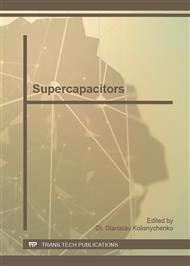p.1211
p.1215
p.1219
p.1223
p.1227
p.1231
p.1235
p.1239
p.1243
Solvothermal Synthesis of Nanostructured α-Ni(OH)2/ Mesoporous Carbon Composites for Supercapacitors
Abstract:
Nanostructured α-Ni(OH)2/ mesoporous carbon composites were synthesized by a facile solvothermal method using sodium dodecyle sulfate as a soft template and urea as a hydrolysis-controlling agent. The obtained products were characterized by X-ray diffraction(XRD), and scanning electron microscopy(SEM). Electrochemical properties studies were carried out using cyclic voltammetry(CV) and galvanostaitc charge/discharge method. The results exhibited that the α-Ni(OH)2/ mesoporous carbon composites single electrode had high specific capacitance in KOH electrolyte. The maximum specific capacitance of the α-Ni(OH)2/ mesoporous carbon composites single electrode was up to 2191 F/g in 6 M KOH solution at a charge-discharge current density of 4 mA/cm2, when the mass percent of mesoporous carbon was 5%. It is suggested its potential application in the electrode material for supercapacitors.
Info:
Periodical:
Pages:
1227-1230
Citation:
Online since:
May 2011
Authors:
Price:
Сopyright:
© 2011 Trans Tech Publications Ltd. All Rights Reserved
Share:
Citation:



